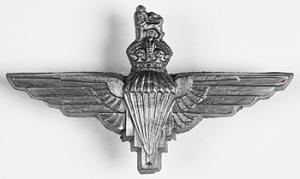Active 1941–19481948–Present Role Air assault infantry | Type Airborne infantry | |
 | ||
The 3rd Battalion, Parachute Regiment (3 PARA), is a battalion sized formation of the British Army's Parachute Regiment and is a subordinate unit within 16 Air Assault Brigade.
Contents
Roled as an Airborne light infantry unit, the battalion is capable of a wide range of operational taskings. Based at Merville Barracks, Colchester Garrison, their barracks in England, personnel regularly deploy outside of the United Kingdom on operations and training.
All personnel will have completed the Pre Parachute Selection (P Company) course at Depot PARA at Catterick, North Yorkshire (previously Aldershot, Hampshire), entitling them to wear the maroon beret.
A unique part of the 3rd Battalion is the inclusion of the Guards Parachute Platoon, which is incorporated into B Company and also known as 6 (Guards) Platoon. The Guards Parachute Platoon is made up of volunteers who have passed P Company from the five Regiments of Foot Guards and Infantry qualified members of the Household Cavalry; they can be distinguished from other paratroopers by a "blue red blue" patch sewn to their beret beneath the Parachute Regiment cap badge.
Background
Impressed by the success of German airborne operations during the Battle of France, the British Prime Minister, Winston Churchill directed the War Office to investigate the possibility of creating a corps of 5,000 parachute troops. On 22 June 1940, No. 2 Commando was redeployed to parachute duties and on 21 November re-designated the 11th Special Air Service Battalion, with both a parachute and glider wing, the men of which took part in the first British airborne operation, Operation Colossus, on 10 February 1941. The success of the raid prompted the War Office to expand the airborne forces, setting up the Airborne Forces Depot and Battle School in Derbyshire in April 1942, and creating the Parachute Regiment as well as converting a number of infantry battalions into airborne battalions in August 1942.
All parachute forces had to undergo a twelve-day parachute training course at No. 1 Parachute Training School, RAF Ringway. Initial parachute jumps were from a converted barrage balloon and finished with five jumps from an aircraft. Anyone failing to complete a descent was returned to his old unit. Those men who successfully completed the parachute course were presented with their maroon beret and parachute wings.
Airborne soldiers were expected to fight against superior numbers of the enemy armed with heavy weapons, including artillery and tanks. Training was as a result designed to encourage a spirit of self-discipline, self-reliance and aggressiveness. Emphasis was given to physical fitness, marksmanship and fieldcraft. A large part of the training regime consisted of assault courses and route marching while military exercises included capturing and holding airborne bridgeheads, road or rail bridges and coastal fortifications. At the end of most exercises, the battalions would march back to their barracks. An ability to cover long distances at speed was also expected: airborne platoons were required to cover a distance of 50 miles (80 km) in twenty-four hours, and battalions 32 miles (51 km).
3rd Battalion
The 3rd Parachute Battalion was formed in 1941 from volunteers from various infantry regiments. It became part of the 1st Parachute Brigade, later part of the 1st Airborne Division. The battalion first saw action during the Operation Torch landings, and then further operations in North Africa, by the independent 1st Parachute Brigade. After the Tunisian campaign, the battalion and brigade rejoined the 1st Airborne Division, and took part in Operation Fustian in Sicily, and Operation Slapstick on the Italian mainland.
Withdrawn to Britain with the rest of the 1st Airborne Division, the next mission was during Operation Market Garden and the Battle of Arnhem, during which the battalion was virtually wiped out. Afterwards, the battalion was reformed but never saw any further action during the Second World War, though it may have gone to Norway with the initial reoccupation force in 1945. The battalion was then assigned to the 3rd Parachute Brigade in the 6th Airborne Division and served with them in Palestine. The battalion was disbanded in 1948, but was reformed by the re-numbering of the 7th (Light Infantry) Parachute Battalion as the 3rd later the same year.
The battalion was deployed in Northern Ireland 12 times between 1971 and 2004, during the Troubles. In the summer of 1976, it was based in South County Armagh, where complaints were made of its treatment of residents.
In 1981, it joined 5th Infantry Brigade at Aldershot on the reconversion of British Army Field Forces back into brigades. In 1982, it was hurriedly transferred to 3 Commando Brigade, along with 2 PARA, to reinforce that brigade ahead of the Task Force's sailing for the Falklands Conflict. After marching 50 miles across the islands, the Battalion saw action on 11/12 June when it was engaged in the Battle of Mount Longdon.
In October 2013, 3 PARA took part in a large training exercise to return to the Airborne Assault role.
In September 2014, a comprehensive history of the battalion, with numerous links to photos, obituaries and more was found - the creation of Paradata, a 'living history' of the Parachute Regiment and Airborne Forces
3 PARA is training with its anti-tank platoon to take on the AATF role from May 2014, with the unit’s airborne infantry bolstered by artillery, engineers, medics and logisticians from 16 Air Assault Brigade.
